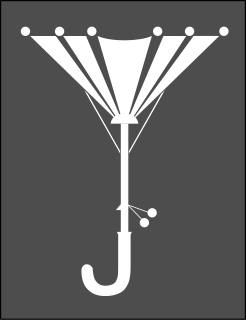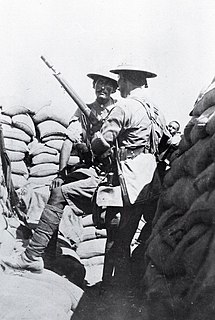Related Research Articles

The 54th Infantry Division was an infantry division of the British Army. The division was raised in 1908 following the creation of the Territorial Force (TF) as the East Anglian Division. During the First World War the division fought at Gallipoli and in the Middle East. The division was disbanded after the war but reformed in the Territorial Army in 1920. During the Second World War it was a home service division and did not see any combat service abroad and was disbanded in late 1943 but many of its component units went to see service in the Normandy Campaign and North-western Europe from June 1944 to May 1945.

The 60th Division was an infantry division of the British Army raised during the First World War. It was the second line-formation of the 47th Division, and was the second of two such Territorial Force divisions formed from the surplus of London recruits in 1914.

The 31st Division was an infantry division of the British Army. It was raised in the Great War by volunteers from Kitchener's Army and formed in April 1915 as part of the K4 Army Group and taken over by the War Office on 10 August 1915. Comprising mainly infantry battalions from Yorkshire and Lancashire, the division was sent to Egypt in December 1915 before moving to France in March 1916 and spent the remainder of the First World War in action on the Western Front. The 31st Division was the quintessential New Army division, being made up entirely of Pals battalions.

The British Expeditionary Force order of battle 1914, as originally despatched to France in August and September 1914, at the beginning of World War I. The British Army prior to World War I traced its origins to the increasing demands of imperial expansion together with inefficiencies highlighted during the Crimean War, which led to the Cardwell and Childers Reforms of the late 19th century. These gave the British Army its modern shape, and defined its regimental system. The Haldane Reforms of 1907 formally created an Expeditionary force and the Territorial Force.

The 7th (Meerut) Division was an infantry division of the British Indian Army that saw active service during World War I.
The 3rd (Lahore) Division was an infantry division of the British Indian Army, first organised in 1852. It saw service during World War I as part of the Indian Corps in France before being moved to the Middle East where it fought against troops of the Ottoman Empire.
XLIV (Howitzer) Brigade, Royal Field Artillery was a brigade of the Royal Field Artillery which served in the First World War. It joined the BEF in August 1914 before being broken up in May 1916. It was reformed as XLIV Brigade, Royal Field Artillery in early 1917, serving in Palestine and the Western Front before being disbanded after the end of the war.
XIV Brigade, Royal Horse Artillery was a brigade of the Royal Horse Artillery which existed in the early part of the 20th century. It had been dissolved before World War I but was reformed for the war. It served with 7th Division on the Western Front before becoming XIV Army Brigade, RHA in February 1917. It was disbanded at the end of the war.
XV Brigade, Royal Horse Artillery was a brigade of the Royal Horse Artillery formed during World War I. It served with 29th Division in the Gallipoli Campaign and on the Western Front. It was disbanded after the war.
V Lowland Brigade, Royal Field Artillery was a field artillery brigade formed from three Territorial Force Royal Horse Artillery batteries in January 1916. It was assigned to the 52nd (Lowland) Division to replace I Lowland Brigade, RFA (T.F.) and joined the division in Egypt.
The Essex Royal Horse Artillery was a Territorial Force Royal Horse Artillery battery that was formed in Essex in 1908. It saw active service during the First World War in Egypt and Palestine from 1916 to 1918, initially as field artillery with 52nd (Lowland) Division before being converted back to horse artillery and serving with the 2nd Mounted / 5th Cavalry Division. A second line battery, 2/1st Essex RHA, served on the Western Front in 1917 and 1918 as part of an Army Field Artillery Brigade.
The Glamorganshire Royal Horse Artillery was a Territorial Force Royal Horse Artillery battery that was formed in Glamorganshire in 1908. It saw active service during the First World War on the Western Front in 1917 and 1918 as part of an Army Field Artillery Brigade. A second line battery, 2/1st Glamorganshire RHA, served in England and Ireland before being broken up in January 1917. Glamorganshire RHA was not reconstituted in the post-war Territorial Force.

The Leicestershire Royal Horse Artillery was a Territorial Force Royal Horse Artillery battery that was formed in Leicestershire in 1908. It saw active service during the First World War in Egypt and Palestine from 1916 to 1918, initially with ANZAC Mounted Division before joining the Yeomanry Mounted Division and 1st Mounted / 4th Cavalry Division. A second line battery, 2/1st Leicestershire RHA, served on the Western Front with the 63rd Division from 1916 to 1918. Post-war, it was reconstituted as a Royal Field Artillery battery.
The Shropshire Royal Horse Artillery was a Territorial Force Royal Horse Artillery battery that was formed in Shropshire in 1908 from the Shropshire Battery of the 1st Shropshire and Staffordshire Artillery Volunteers, Royal Garrison Artillery of the Volunteer Force. It saw active service during the First World War on the Western Front in 1917 and 1918 as part of an Army Field Artillery Brigade. A second line battery, 2/1st Shropshire RHA, also served on the Western Front in 1917 and 1918 as part of another Army Field Artillery Brigade. It was reconstituted post-war as a medium artillery battery and served as such in the Second World War.
The Warwickshire Royal Horse Artillery was a Territorial Force Royal Horse Artillery battery that was formed in Warwickshire in 1908. It was the first Territorial Force artillery unit to go overseas on active service, spending the whole of the First World War on the Western Front, mostly with 1st Cavalry Division and 29th Division. A second line battery, 2/1st Warwickshire RHA, also served on the Western Front in 1917 and 1918 as part of an Army Field Artillery Brigade. Post-war it was reconstituted as a Royal Field Artillery battery.
The 2nd Kent Artillery Volunteers, later 4th London Brigade, Royal Field Artillery, popularly known as the Lewisham Gunners, was a volunteer unit of the British Army from 1860 until 1967. Initially raised in suburban West Kent, its recruiting area was later incorporated within the County of London. It provided two active service units in each of the World Wars, operating as far afield as Sicily, Burma and Madagascar, and later provided an airborne unit in the Territorial Army of the 1950s.
The 1st Suffolk Artillery Volunteers was a unit of Britain's Volunteer Force and Territorial Army from 1860 until 1955. Raised at Lowestoft in Suffolk, it served under various designations, as field artillery in Palestine during World War I and as heavy anti-aircraft artillery defending the UK during World War II.
The 1st Cinque Ports Artillery Volunteers was a part-time unit of the British Army's Royal Artillery from 1860 to 1956. Raised as coastal defence artillery, the unit later served as field artillery in Mesopotamia during World War I, and as anti-aircraft artillery during the Blitz and in the Middle East during World War II.
The Cheshire Artillery Volunteers was a brigade of Volunteer artillery units raised in the county of Cheshire in the mid-19th Century. Their successors served as field artillery in Palestine during World War I and as anti-aircraft (AA) gunners in the Middle East in World War II. They continued in the air defence role in the Territorial Army until 1955.

The II Wessex Brigade was a howitzer unit of the Royal Field Artillery in Britain's Territorial Force (TF) that was formed on the Isle of Wight in 1908. It served in India and the Middle East during World War I, one of its batteries being captured at the Siege of Kut in Mesopotamia in 1916, and another seeing active service in the Third Afghan War of 1919. Although reformed after the war, the unit was broken up in 1927.
References
- ↑ "The Royal Artillery". Ministry of Defence (United Kingdom). Archived from the original on 23 October 2013. Retrieved 13 April 2013.
- ↑ Baker, Chris. "What was an artillery brigade?". The Long, Long Trail. Retrieved 13 April 2013.